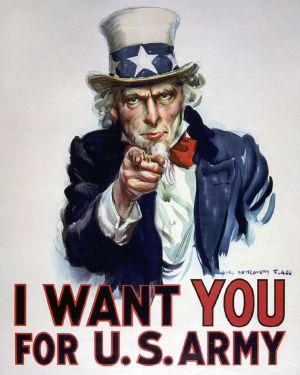Uncle Sam
- This article is about the national personification of the USA. For other uses, see Uncle Sam (disambiguation).

Uncle Sam is a national personification of the United States, with the first usage of the term dating from the War of 1812 and the first illustration dating from 1852. He is often depicted as a serious elderly man with white hair and a goatee, with a strong resemblance to President Abraham Lincoln, and dressed in clothing that recalls the design elements of the flag of the United States—for example, a top hat with red and blue stripes and white stars on a blue band, and red and white trousers.
Origin of the Name
Common folklore holds origins trace back to soldiers stationed in upstate New York, who would receive barrels of meat stamped with the initials U.S. The soldiers jokingly referred to it as the initials of the troops' meat supplier, Samuel Wilson of Troy, New York. The 87th United States Congress adopted the following resolution on September 15, 1961: "Resolved by the Senate and the House of Representatives that the Congress salutes Uncle Sam Wilson of Troy, New York, as the progenitor of America's National symbol of Uncle Sam." A monument marks his birthplace in Arlington, Massachusetts, and a monument marks his burial in Oakwood Cemetery, Troy, New York. Another sign marks "The boyhood home of Uncle Sam" outside his second home in Mason, NH. The first use of the term in literature is seen in an 1816 allegorical book, The Adventures of Uncle Sam in Search After His Lost Honor by Frederick Augustus Fidfaddy, Esq., also in reference to the aforementioned Samuel Wilson.
Another theory suggests that Uncle Sam was a creation by Irish immigrants to the U.S. who used the Gaelic acronym, SAM, or Stáit Aontaithe Mheiriceá, which is the translation for United States of America, as a nickname for their new host country. However, the precise origin of the term may never be proven.
Earlier representative figures of the United States included such beings as "Brother Jonathan," used by Punch magazine. These were overtaken by Uncle Sam somewhere around the time of the Civil War. The female personification "Columbia" has seldom been seen since the 1920s.
Other media
In addition to the appearance of Uncle Sam in politics, the character has also appeared as a comic book hero for both Quality and DC Comics. He is presented as the living embodiment of the United States and is the leader of the Freedom Fighters. See Uncle Sam (comics). There was also a short cartoon in the 1980s called "Uncle Sam's Adventures."
Furthermore, Uncle Sam appeared as a horror villain in the eponymously titled 1997 film, Uncle Sam. In this film, a veteran who died during Desert Storm rises from the dead to exact justice upon some teenagers who burned the American Flag on his grave.
Major League Baseball's New York Yankees feature Uncle Sam's hat in their team logo, where it sits atop a bat that forms the vertical line of the "K" in "Yankees". The hat is frequently used in imagery pertaining to the team, and fans often wear Uncle Sam hats to games or other functions.
In music, rock group Grateful Dead featured a skeletal Uncle Sam as one of the band's symbols. Uncle Sam, referred to in their song U.S. Blues, is one of the many elements that compose the band's "American mythology".
In the Superkids comic Making of America, Chuck the mouse wears an Uncle Sam costume. In the comic, George Washington shows the costume to Betsy Ross and that gives her the idea of the design of the American flag. In the World War II issue Chuck sees an Uncle Sam poster and says "That looks farmiliar" remembering the Alamo and his love Sir Benjamin the Great.
In the 2007 film Across the Universe, Uncle Sam comes to life and reaches out of his poster to grab Max into the U.S. army, while singing the Beatles song "I Want You (She's So Heavy)".
See also
General subject
- National personification
- Nationalism
National context
- UK : John Bull
- Northern Europe : Finnish Maiden
- US : Samuel Wilson, Yankee Doodle
- Brother Jonathan
- France : Marianne
- Germany & Austria : Germania, Deutscher Michel
- Sweden : Mother Svea
Related parodies
- Uncle Jam Wants You (album by Funkadelic)
Bibliography
- Fenster, Bob. They Did What!?, Andrews McMeel Publishing, 2003. ISBN 0-7407-3793-7
ReferencesISBN links support NWE through referral fees
- ↑ The Most Famous Poster. American Treasures of the Library of Congress.
External links
- "The Most Famous Poster," U.S. Library of Congress
- Historical Uncle Sam Pictures
- James Montgomery Flagg's 1917 "I Want You" Poster and other works (Internet Archive copy from 2004 October 28)
- What's the origin of Uncle Sam? The Straight Dope
- "USA Thinking Team" - new images of a modern Uncle Sam promoting peace. Messages from his helpmate, Aunt Sarah.
ar:العم سام ast:Tíu Sam da:Uncle Sam de:Uncle Sam es:Tío Sam eo:Uncle Sam fr:Oncle Sam ko:엉클 샘 id:Paman Sam it:Zio Sam he:הדוד סם lt:Dėdė Semas hu:Uncle Sam ml:അങ്കിള് സാം nl:Uncle Sam ja:アンクル・サム no:Uncle Sam pl:Wuj Sam pt:Tio Sam ru:Дядя Сэм fi:Setä Samuli sv:Uncle Sam vi:Chú Sam ur:چچا سام zh:山姆大叔
Credits
New World Encyclopedia writers and editors rewrote and completed the Wikipedia article in accordance with New World Encyclopedia standards. This article abides by terms of the Creative Commons CC-by-sa 3.0 License (CC-by-sa), which may be used and disseminated with proper attribution. Credit is due under the terms of this license that can reference both the New World Encyclopedia contributors and the selfless volunteer contributors of the Wikimedia Foundation. To cite this article click here for a list of acceptable citing formats.The history of earlier contributions by wikipedians is accessible to researchers here:
The history of this article since it was imported to New World Encyclopedia:
Note: Some restrictions may apply to use of individual images which are separately licensed.
